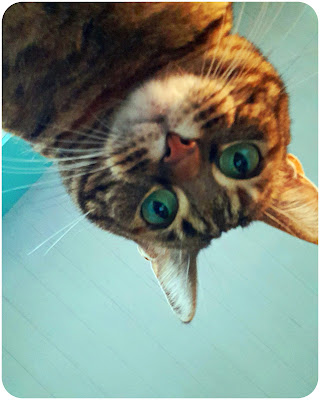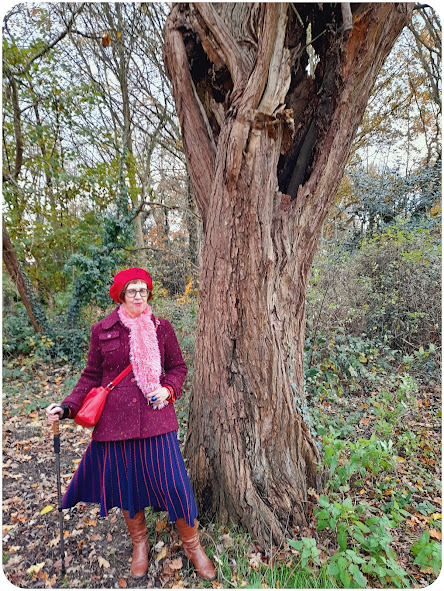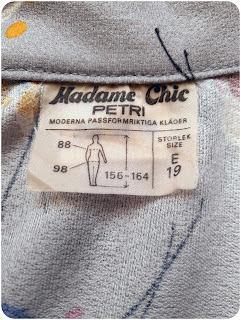... and what a year it has been! A true annus horribilis if ever there was one - although it wasn't ALL bad, I hasten to add. I've got the fondest memories of our Shropshire holiday and meeting up with Vix and Claire, for instance. But 2024 and I got off on the wrong foot only days in, when an unpleasant altercation with my bosses poisoned my days for several weeks to come.
However, all this, plus the generally under par weather and the doom and gloom in the world at large instantly paled into insignificance when Jos started having serious health problems back in September. The subsequent events rather knocked us both for six and turned our world upside down, so let's keep our fingers crossed for an infinitely better 2025.
For now though, let's cast our minds back to Saturday the 7th of December! If initially this felt like absolutely ages ago and I was thinking I'd been letting standards drop, blog-wise, I was relieved to find that I was in exactly the same position when I published last year's final post.
I totally loved the outfit I wore that day, the combo of super-strokable forest green suedette skirt - bought brand new at Mango many years ago - and charity shopped multi-coloured Caroline Biss cowl neck jumper managing to make me feel both fabulous and comfortable. The stretchy belt was charity shopped as well while the brooch, which I'm inviting you to take a proper look at in a minute, was either bought from H&M or Accessorize about twenty years ago.
Whatever its origins, the fact remains that this is one of the brooches which kick-started my collection, which at the time I obviously had no inkling would take on such proportions :-)
Isn't this tree of life with three birds perching in its branches utterly gorgeous? I've lost count of the number of times that people asked me whether it's vintage. Well, perhaps it is after twenty years ...
But I happened to mention a deluge of vintage and other finds in my previous post, so I suggest I get cracking with what I found in the charity shop that Saturday.
The brocade midi dress on the top left is from EDC by Esprit, which filed for bankruptcy in Belgium and other European countries earlier this year. Funnily enough, I don't remember ever buying anything from their Antwerp shop, which is around the corner from my office, its empty premises currently taken over by a huge pop-up Christmas shop!
The black mock-croc belt proved to be a perfect companion for the dress.
I fell head over heels for the Missoni-esque skirt on the bottom right. I can't wait to wear this one in the Spring!
The temperature, which had remained stuck at around 10°C for the last couple of days, had taken a dive into the single digits on Sunday. Dark and gloomy, with the odd bout of drizzle, I had a hard time dragging myself from the cozy confines of my bed that morning, particularly as I had another list of those never-ending household chores to tick off.
No reason not to dress up though! Surely, wearing such a fabulously patterned frock makes even a morning of vacuuming, mopping and dusting, if not enjoyable, then certainly more bearable.
In spite of its long sleeves and high neckline, it's not the warmest of garments, so I was wearing plenty of layers underneath and a snuggly, fluffy orange cardigan on top.
Dress: Think Twice
Cardigan: charity shopped
Opaques, ankle boots, belt and felted flower corsage bought on the high street
I spent the afternoon on the sofa, finishing my latest read, Laurie Graham's Gone with the Windsors,
which was quite hilarious at times. The book is the diary of Mrs Simpson's fictional best friend in pre-war London, a wealthy American widow who arrives in London in 1932 and discovers that her old school friend is also in town: a certain Bessie Wallis Warfield, now Mrs Ernest Simpson.
The working week ahead continued to be gloomy but mostly dry, the temperature steadily going down from 6°C on Monday to 3°C by the end of the week.
As I walked into the shopping centre near my office, where the majority of the regular shops have been replaced by a bevy of pop-up ones, my eyes alighted on this fabulous pair of magenta suede boots in one of the latter. A handwritten card proclaimed that all boots and shoes were € 20. What's more, they all turned out to be sales samples and were all in my size, 37 or UK size 4! Needless to say, I didn't hesitate for one second.
Then I ummed and ahhed over another pair which in the end I didn't buy ... at least not that day.
Tuesday's lunch break was spent walking down to the Think Twice shop nearest my office, where another one of their famous sales rounds was in full swing, with all garments going for € 5. Not a bad price for two jackets, one of them three-quarter sleeved and probably handmade, the other vintage Harris Tweed!
I also snaffled this burnt orange velvet turban, which was just perfect to combat the chilly weather, keeping my ears warm and toasty. I made this selfie for the benefit of my friend Inez while on the tram home. Clearly I haven't got Bess's talent for making selfies, but never mind that.
As that other pair of boots kept playing on my mind, I decided to have another look at them on Wednesday. I'm still not sure what kept me from buying them on Monday, as clearly they were meant for me. And who doesn't need a pair of purple Western style ankle boots in their wardrobe? I know I do!
And they've already had a lot of wear too, starting with Friday the 13th of December.
Charity shopped back in February, this blue, black and burgundy patterned skirt in a thick blanket-like fabric originally came from & Other Stories. It's such a treat to wear on a cold Winter's day, so I'm thankful for whoever had been foolish enough to get rid of it.
Its companion this time around was a blue vintage jumper from Think Twice. My mohair beret, which happened to match my boots, was found at Think Twice as well. It might have been cold but I was primarily wearing it to hide my hair, which was sorely in need of a wash. Such a slob!
My red-eyed deer brooch came out to play among my jumper's flower pattern. I remember finding it in a long gone vintage shop on a Sunday afternoon back in the mists of time. The painted wooden beads were charity shopped earlier this year.
What with the weather gods once again refusing to play nicely, we cancelled plans for a walk and went charity shopping instead. Which wasn't much of a hardship, obviously.
Riffling through the rails of dresses, I found these two vintage Diolen ones in the XL section. They were a 1970s size 42 and 44 respectively, but I'm currently about a size 40 and they both fit me perfectly, which shows how much sizing has shifted over the decades. Sizing being quite haphazard at the best of times, it always pays to look through all sections, from XS to XL and beyond ...
Forever on the lookout for tank tops, I was happy to come across this gorgeous tan cable-knit one, which shows every sign of having been handmade. It's just what I had been looking for and has already been worn in the meantime.
I also fell hard for this maroon atomic patterned vintage jumper!
My final find was a chocolate brown embroidered and rick-racked tiered linen skirt. It's by the French Devernois label and I'm imagining myself floating around in it on a warm Summer's day.
It's absolutely perfect apart from a couple of minor stains, which I intend to spot clean as its care label says dry cleaning only.
I'll be wrapping up 2024 in my next post, but for now I'll leave you with these photos of Her Royal Highness, who is wishing you all a Happy New Year!
I'll be in my pyjamas after dinner, and will probably nod off before the clock strikes 12!






























































